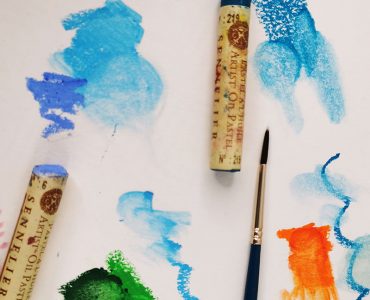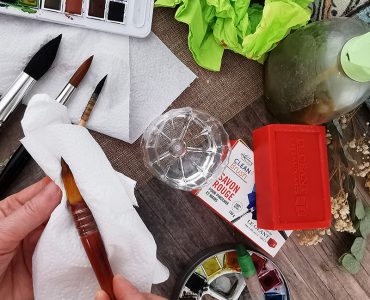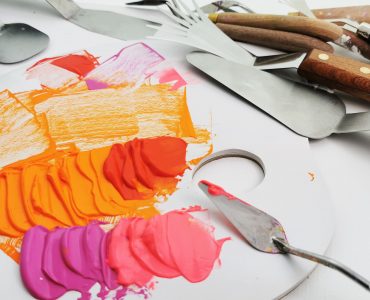A brush, the natural extension of the artist’s hand…
But it was not until the Renaissance that the Italian Cennino Cennini de-mystified the production of brushes with squirrel, deer, and hog hair in his book ‘The Craftsman’s Handbook’, published in 1437.
Around 1500 Leonardo Da Vinci discovered capillarity action – the capacity of the hair to absorb and retain a lot of liquid for a more regular application of the colour –, a principle put into practice by brushmakers. The invention of metal ferrules around 1750, binding the bristles and the handle together, sent the manufacture of brushes into the industrial era and was a crucial innovation for the specialists of this craft.
A meticulous handcrafted work
Artists’ brushes are the result of meticulous handcrafted work, and each technique requires a particular shape and composition. For example, a watercolour brush has a short and well-balanced handle, a round ferrule and a V-shaped fine tip, whereas an acrylic brush has a long handle and a flat or round tip, and because acrylic paint dries really quickly, the tip must offer great elasticity and perfect resistance.
Oil brushes must also have long handles. You can use flat brushes for large and dense applications whereas you will prefer to use round brushes for detail work. The “cat tongue” offers a perfect compromise between flat and round brushes. Whether the support – paper, linen or cotton canvas, wood etc – has a texture that is smooth, soft or coarse, and also the application type – impastos, tint areas, glazes – are crucial criteria in the choice of your brush.
You will find these three elements in all brushes:
- the hair,
- the ferrule,
- the handle.
The hair is the living part of the brush and has 3 functions: absorption of the colour, retention of the water – important for wet techniques – and distribution of the paint. The capillarity, the stock and the elasticity of the hair must help the artist to harmoniously apply the colours onto the support. There are two types, natural hair – which can be either extra-fine (sable, squirrel), fine (polecat, ox, pony, goat) or even bristle (hog) – and synthetic hair.
Natural Hair
Natural extra fine hair is scattered with scales that allow excellent absorption of the pigments during colour-taking and also favour water retention. This is presented like a spindle with a more or less accentuated belly, and the arrangement of the hair in the brush tuft will form the belly whose density will form the stock of water and colour.
The distribution depends on the sensitivity of the hair. The most expensive and precious natural, extra-fine hair are the ones of the sable, living in the coldest Siberian and Manchurian regions, notably on the banks of Siberian rivers such as the Amur, the Tobol, the Ob, the Lena or the Usuri. Because of the environment, its superb golden-red hair with its satin brightness is resistant, fine and flexible.
Kolinsky Red Sable
The brush makers use the name “Kolinsky Red Sable” for this hair quality used for watercolour round brushes, oil flat brushes and retouch brushes among others.
Perfect for wash tints and fluid techniques, squirrel hair is the finest natural hair. Its colour changes according to the origins of the animal: it is brown on the Kazan squirrel (Russia), blue on the Saccamina one and golden on the Canadian one. Its absorption capacity is remarkable: its volume increases by 20% when it is wet.
Fine polecat hair from Russia or Central Europe is used in the manufacture of watercolour brushes and particularly for oil flat, round and cat tongue brushes. Also used are ox hair (the longest and most solid), pony hair or Kevrin hair (very fine and oily).
Synthetic hair
Because of the extraordinary technical progresses in the manufacture of synthetic fibres for brushes, these brushes have become much more prominent over the last 50 years. The Japanese were the pioneers in this field and it all began with the invention of nylon and nylon 6, whose remarkable elasticity made them ideal for brushes.
These remarkable fibres were more resistant than natural hair on coarse supports so they were further developed to match the softness and solidity of natural hair. Synthetic hairs are perfect for acrylic because the resin contained within the paint binds the fibres together to form the tuft during the colour-taking. Nowadays some manufacturers combine qualities to offer mixed-tip brushes composed of both synthetic and natural hair.
Hairs whether fine, extra-fine, synthetic or bristles are prepared in bottles in order to be combined as round, flat, rounded, cat tongue, fan or square tips in the ferrule.
The Ferrule
This is a crucial invention in the history of brushes as the ferrule – conical or cylindrical – forms the bond between the hair and the handle. It is metallic (copper, silver, aluminium, nickel-plated brass, tin) or natural (goose quill). Its oxidation resistance must be optimal on a watercolour brush, given the frequency of the contact of the brush with moisture. With the exception of the tin ferrule, it is usually seamless. Its finish can be varnished, nickel-plated or golden.
The Handle
The handle is prepared and sanded. It is made with young natural wood such as:
- birch,
- ash,
- beech,
- oak,
- wenge.
The handle is then coated, lacquered or varnished. It must be pleasant to the artist’s touch. Its length and shape varies according to the painting technique. The handle of a watercolour brush is often shorter than the one of an acrylic or oil brush, and the tip of certain handles is pointed, which allows refining or graffito effects.
Discover GreatArt full range of brushes available online at www.greatart.co.uk/brushes and in-store.
GreatArt – your art superstore
Art supplies, ideas and advice for all techniques.
GreatArt offers you art supplies for all techniques from:
- traditional fine art painting,
- drawing,
- sculpture,
- printmaking,
- graphic art,
- illustration,
- airbrushing,
- model making…
We offer an extensive range of stretched canvas and display products for exhibition, all the art supplies required to create your own bespoke canvases, as well as custom framing and mounting services from GreatArt Store. You’ll also find hundreds of articles and tutorials to browse in the online magazine.





















Add comment